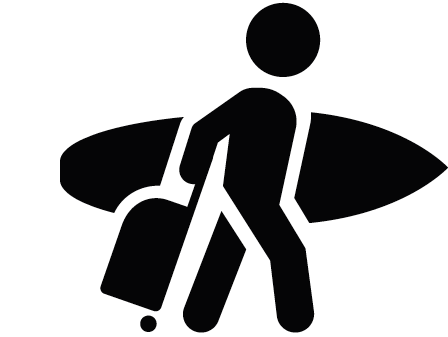Surfing in Haiti

Haiti is the third largest Caribbean nation and is located on the western side of Hispaniola Island. Haiti is known for being the only nation to have a successful slave revolt that led to a free nationhood. Recent history has been marked by repressive dictatorships and military coups resulting in Haiti being the poorest nation in the northern hemisphere. The good news is that there is no doubt that Haiti gets good surf on both coasts. The more remote north coast has shallow reefs that are very exposed to winter NE swells and the south coast is closer to the capital and has numerous surf breaks with quality waves. “The Pearl of the Antilles'', as the country is known it’s unique in so many ways. It’s one of the few Caribbean nations that has virtually zero tourism but this gives you a chance to go out of your comfort zone. Haitians are extremely friendly and surprisingly happy and they have a unique culture with great food and interesting indigenous arts and crafts. Surfers are adventurous by nature and political turmoils shouldn’t deter you from exploring this amazing country and finding some epic and empty waves on your way.
Climate in Haiti
The climate in Haiti is tropical with warm and humid weather all year round. There is a cool and dry period from November to March. This is when the trade winds from the northeast prevail and average temperatures range in between 15-25°C (59-77°F). From May to October it’s hotter and wetter and average temperatures are in between 25-35°C (77-95°F). The best time to surf in the country is from November to March when solid winter swells come from the north atlantic. The hurricane season happens from June to October, and can bring some unexpected waves to the haitian shoreline. Water temperature is always above 25°C (77°F), making it comfortable to surf in a pair of boardshorts all year round.
Best surf spots in Haiti
There are two different areas for surfing in Haiti - north coast and south coast. The best surf spots in the north coast are La Pointe, Le Borgne, Ginsu and Caracol. On the south coast it’s worth checking out Pistons, Rainbow Beach, Torbeck, Mahaut Hugues, Les Anglais and Tiburon Reefs.
Budget Planning
Meal price range
Simple meals start at $10 USD. Mid-range meals start at $20 USD. Dining & drinking at high-end restaurants can cost anywhere from $40-60 USD
Equipment rental
There are a couple of places where you can rent gear. Boards start at $15 USD for half day.
Prepaid SIM cards
Digicel is a good choice. SIM cards can be purchased from retailers, kiosks and the airport.
Prepaid packages start at $1 USD.
Public transport
Getting around Haiti by bus and minibus isn’t always comfortable, but it’s the cheapest way to travel within the country.
Motos are privately owned motorcycle taxis. They function well as a replacement for regular taxis, which you won’t find in Haiti. Moto drivers are widely available and ready to take you anywhere.
Public boat taxis are common and relatively affordable in the north and south of Haiti for transport between locations not connected by roads.
The main roads are potholed and cracked. Secondary roads are worse. If you’re going to rent a car, it should be 4WD. Rental prices are pretty pricey however, starting at around $100 USD a day.
Gas prices
$0.56 USD a liter.
Types of risks
Sea urchins, staghorn coral, and shallow waters. Earthquakes, hurricanes, poverty.
How to prepare
Visa
Citizens from most countries, including EU, US, UK, and Australia, can stay visa free for 3 months. You’ll pay a $10 USD fee on arrival. Citizens from only 9 countries require a visa before arrival.
Vaccines
Although it's not mandatory, it’s recommended that you have been vaccinated for hepatitis A & B, yellow fever, typhoid, rabies, meningitis, polio, Tdap, chickenpox, shingles, pneumonia, influenza, measles, mumps and rubella. You’ll be asked to show proof of your yellow fever vaccination if you come from a country with a risk of yellow fever.
Things to know
Language & Currency
The official language is Creole and French. With most speaking only Creole. You will not find a lot of English speakers.
The currency is Haitian gourde (HTG). There is also the Haitian dollar which is unofficial, but widely used.
Best time to go
November to March.
Checking Surf forecast
Checking the forecast about a week before your trip is always a good idea. Understanding what the waves will be like and knowing what gear to pack is essential. You can check the forecast for the waves here.
Do I need pack a pharmacy kit
You should bring a basic kit. Including ear drops, eye drops, bandaids, ear plugs, gaze, alcohol, mosquito repellent and broad spectrum antibiotic ointment.
Travel/Surf Insurance
World Nomads has great travel insurance packages that are not super expensive and they cover surfing.
Emergency
Dial 114
Check surf pictures of Haiti at #surfhaiti.

